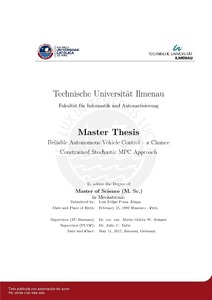| dc.contributor.advisor | Selassie, Abebe Geletu W. | |
| dc.contributor.advisor | Tafur, Julio C. | |
| dc.contributor.author | Poma Aliaga, Luis Felipe | es_ES |
| dc.date.accessioned | 2017-06-19T22:33:50Z | es_ES |
| dc.date.available | 2017-06-19T22:33:50Z | es_ES |
| dc.date.created | 2017 | es_ES |
| dc.date.issued | 2017-06-19 | es_ES |
| dc.identifier.uri | http://hdl.handle.net/20.500.12404/8834 | |
| dc.description.abstract | In recent years, there is a growing interest in the development of systems capable of performing
tasks with a high level of autonomy without human supervision. This kind of systems are known as
autonomous systems and have been studied in many industrial applications such as automotive,
aerospace and industries. Autonomous vehicle have gained a lot of interest in recent years and have
been considered as a viable solution to minimize the number of road accidents. Due to the
complexity of dynamic calculation and the physical restrictions in autonomous vehicle, for example,
deterministic model predictive control is an attractive control technique to solve the problem of
path planning and obstacle avoidance. However, an autonomous vehicle should be capable of driving
adaptively facing deterministic and stochastic events on the road. Therefore, control design for
the safe, reliable and autonomous driving should consider vehicle model uncertainty as well
uncertain external influences. The stochastic model predictive control scheme provides the
most convenient scheme for the control of autonomous vehicles on moving horizons, where chance
constraints are to be used to guarantee the reliable fulfillment of trajectory constraints and
safety against static and random obstacles. To solve this kind of problems is known as chance
constrained model predictive control. Thus, requires the solution of a chance constrained
optimization on moving horizon. According to the literature, the major challenge for solving chance
constrained optimization is to calculate the value of probability. As a result, approximation
methods have been proposed for solving this task.
In the present thesis, the chance constrained optimization for the autonomous vehicle is solved
through approximation method, where the probability constraint is approximated by using a smooth
parametric function. This methodology presents two approaches that allow the solution of chance
constrained optimization problems in inner approximation and outer approximation. The aim of this
approximation methods is to reformulate the chance constrained optimizations problems as a sequence
of nonlinear programs. Finally, three case studies of autonomous vehicle for tracking and obstacle
avoidance are presented in this work, in which three levels probability of reliability are
considered
for the optimal solution. | es_ES |
| dc.description.uri | Tesis | es_ES |
| dc.language.iso | eng | es_ES |
| dc.publisher | Pontificia Universidad Católica del Perú | es_ES |
| dc.rights | Atribución-NoComercial-SinDerivadas 2.5 Perú | * |
| dc.rights | info:eu-repo/semantics/openAccess | es_ES |
| dc.rights.uri | http://creativecommons.org/licenses/by-nc-nd/2.5/pe/ | * |
| dc.subject | Control predictivo | es_ES |
| dc.subject | Control automático | es_ES |
| dc.subject | Vehículos | es_ES |
| dc.title | Reliable autonomous vehicle control - a chance constrained stochastic MPC approach | es_ES |
| dc.type | info:eu-repo/semantics/masterThesis | es_ES |
| thesis.degree.name | Magíster en Ingeniería Mecatrónica | es_ES |
| thesis.degree.level | Maestría | es_ES |
| thesis.degree.grantor | Pontificia Universidad Católica del Perú. Escuela de Posgrado | es_ES |
| thesis.degree.discipline | Ingeniería Mecatrónica | es_ES |
| renati.advisor.dni | 06470028 | |
| renati.discipline | 713167 | es_ES |
| renati.level | https://purl.org/pe-repo/renati/level#maestro | es_ES |
| renati.type | http://purl.org/pe-repo/renati/type#tesis | es_ES |
| dc.publisher.country | PE | es_ES |
| dc.subject.ocde | https://purl.org/pe-repo/ocde/ford#2.00.00 | es_ES |






